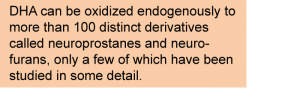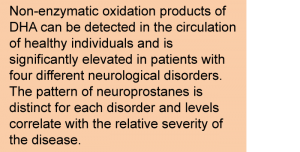Omega-3 LCPUFA Chemical Oxidation Pathways Associated with Cognitive Disorders
This article at a glance
- Neuroprostanes are oxidation products of DHA that are produced endogenously via non-enzymatic pathways. The chemical structure and biological activity has only been characterized for some of the neuroprostanes.
- This study reports that two neuroprostanes, 4-F4t-NeuroP and 10-F4t-NeuroP, are found at elevated levels in patients with multiple scleroris, Down syndrome, Rett syndrome and autism spectrum disorders, compared to matched healthy individuals.
- The new results furthermore indicate that in different neurological conditions, preferential chemical oxidation and rearrangement pathways lead to distinct patterns of neuroprostanes, which may have potential diagnostic value.

Docosahexaenoic acid (DHA) is the most abundant omega-3 long-chain polyunsaturated fatty acid (LCPUFA) in the brain. It is primarily a component of membrane phospholipids, a pool where it contributes to the structural properties and function of cell membranes. DHA can also be released to act as a substrate for the formation of lipid signals that regulate neurotransmission and synaptic plasticity, as well as in the regulation of protection of neurons from injury. Although LCPUFA are important components of the brain, these fatty acids are also very sensitive to reaction with oxygen, a non-enzymatic chemical reaction in which the fatty acid is oxidized.
Organisms are continuously under oxidant “stress” as a consequence of using molecular oxygen for cellular respiration. The body is optimally adapted throughout its life to deal with a permanent flux a variety of oxidized molecules and oxygen radicals that are formed during respiration and redox reactions catalyzed by different enzymes. Under healthy conditions, an array of specialized antioxidant enzymes and antioxidants to limit non-enzymatic oxidation reactions and to detoxify any reactive products that may form, with the aim to maintain the redox state of cells compatible with life in an oxygen-rich atmosphere. In contrast, when this dynamic system is dysregulated, specific components of cells may receive higher than acceptable fluxes of oxidative insult. Cell membranes, which contain oxidizable polyunsaturated fatty acids, are an early target for increased cellular oxidative tone, and lipid peroxidation is frequently observed in a wide range of diseases afflicting humans.

Non-enzymatic PUFA oxidation products can be detected in tissues, the circulation and in urine. The levels of these oxidation products generally increase as a result of specific disorders. For example, membrane oxidation is involved in the conversion of Aβ-24 peptide aggregates to fibrils in Alzheimer’s disease brain tissue, and amyloid plaques composed of Aβ-24 aggregates promote further membrane lipid peroxidation. When a single PUFA molecule, such as arachidonic acid (AA) or DHA, reacts sequentially with molecular oxygen, a variety of structural rearrangements can occur. In the case of AA, so-called isoprostanes are formed. One of these, 8-iso-prostaglandin F2α has been extensively used to monitor oxidative stress in vivo, and can be measured in the circulation and in urine. In the case of DHA, the non-enzymatic oxidized products are called F4-neuroprostanes (F4-NeuroPs) and neurofurans (reviewed in this Guest Article in Fats of Life). More than 100 neuroprostanes and neurofurans can be formed non-enzymatically from DHA oxidation and most of these have not been studied. Two neuroprostanes, 4(RS)-4-F4t-NeuroP (4-F4t-NeuroP) and 10(RS)-10-F4t-NeuroP (10-F4t-NeuroP) have been studied in some detail with respect to their formation and biological activities. Interestingly, several of the characterized neuroprostanes have potent biological activity, such as anti-arrhythmic and anti-inflammatory activity. It is as if the body recognizes chemical oxidation products derived from LCPUFA to trigger functional adaptations in the face of increased lipid peroxidation that may occur under conditions of oxidative stress.
A recent study has explored the formation of neuroprostanes in people with specific neurocognitive disorders. The study was performed by Signorini and colleagues from the Department of Molecular and Developmental Medicine, University of Siena, in Italy, together with colleagues at various university hospitals in Siena, the University of Campania (Naples), the University of Hong Kong, and the University of Montpellier, France. 4-F4t-NeuroP and 10-F4t-NeuroP levels were measured in plasma from patients with four different neurological diseases: multiple sclerosis (MS), autism spectrum disorders (ASD), Rett syndrome (RTT), and Down syndrome (DS). Samples from 16 (MS and DS), 9 (ASD) and 20 (RTT) patients were analyzed.
4-F4t-NeuroP and 10-F4t-NeuroP were found in the plasma of all individuals, indicating that these products reach the circulation and are also produced under normal circumstances in healthy controls. The average plasma level of 10-F4t-NeuroP was significantly elevated in all patients of the four disorders compared to age- and gender-matched healthy subjects (n=61). Increases were in the order of 80 times in ASD and MS, 50 times higher in RTT, and 40 times in DS. 4-F4t-NeuroP levels were >100 fold higher in MS patients, and ~65-fold higher in RTT as compared to controls. However, in ASD and DS no significant increase in 4-F4t-NeuroP levels were observed. The levels of 4-F4t-NeuroP levels and 10-F4t-NeuroP correlated positively with the relative clinical severity of the studied diseases (all pooled, r = 0.469, P <0.0001 and r = 0.757, P < 0.0001, respectively). The marked differences in neuroprostane levels, and evidence for distinct neuroprostane patterns in distinct disorders allowed the researchers to calculate the sensitivities and specificities whereby these substances may assist in predicting the specific neurological conditions.

The results of this study indicate that the formation of two non-enzymatic DHA oxidation products of DHA, 10-F4t-NeuroP and 4-F4t-NeuroP, is markedly increased in different neurological disorders. Differences in the relative formation of these neuroprostanes furthermore suggests that lipid peroxidation processes differ in the distinct disorders. Recently, the analysis of AA-derived oxidation products in brain tissue also revealed several products that were selectively found in Alzheimer’s disease compared to healthy human brain. It is possible that monitoring a wider array of non-enzymatic PUFA oxidation products could provide an even finer distinction between different conditions, or perhaps uncover similarities between neurological diseases. The study has not conclusively demonstrated that the origin of the two neuroprostanes is from brain tissue, as may be expected, or if increased oxidation of LCPUFA is also evident in other tissues. As reported by the researchers, “the neuroprostanes may represent potentially new biological disease markers, and suggest that in vivo DHA oxidation follows preferential chemical rearrangements according to different brain diseases.”
Signorini C, De Felice C, Durand T, Galano JM, Oger C, Leoncini S, Ciccoli L, Carone M, Ulivelli M, Manna C, Cortelazzo A, Lee JC, Hayek J. Relevance of 4-F4t-neuroprostane and 10-F4t-neuroprostane to neurological diseases. Free Radic. Biol. Med. 2018;115:278-287. [PubMed]
Worth Noting
Barden A, Mori TA. GC-MS analysis of lipid oxidation products in blood, urine, and tissue samples. Methods Mol. Biol. 2018;1730:283-292. [PubMed]
Furman R, Lee JV, Axelsen PH. Analysis of eicosanoid oxidation products in Alzheimer brain by LC-MS with uniformly 13C-labeled internal standards. Free Radic. Biol. Med. 2018;118:108-118. [PubMed]
Murray IV, Sindoni ME, Axelsen PH. Promotion of oxidative lipid membrane damage by amyloid beta proteins. Biochemistry 2005;44(37):12606-12613. [PubMed]

